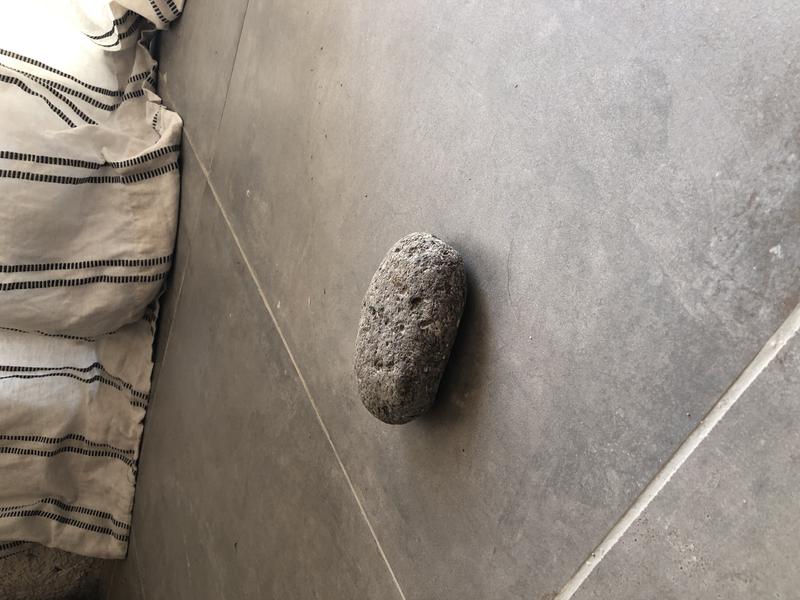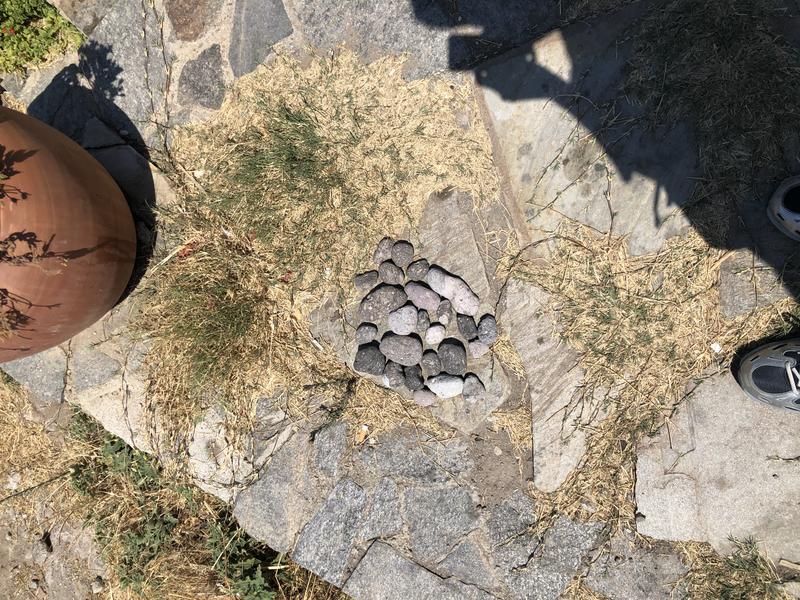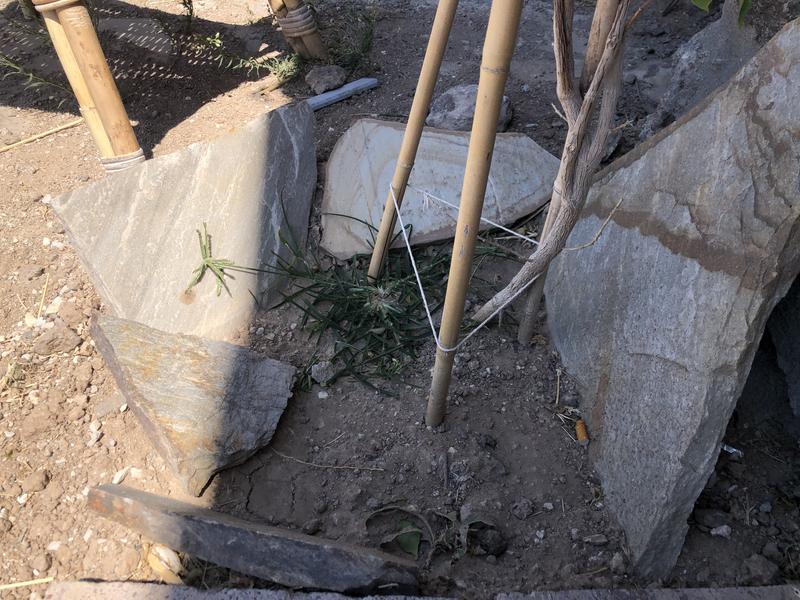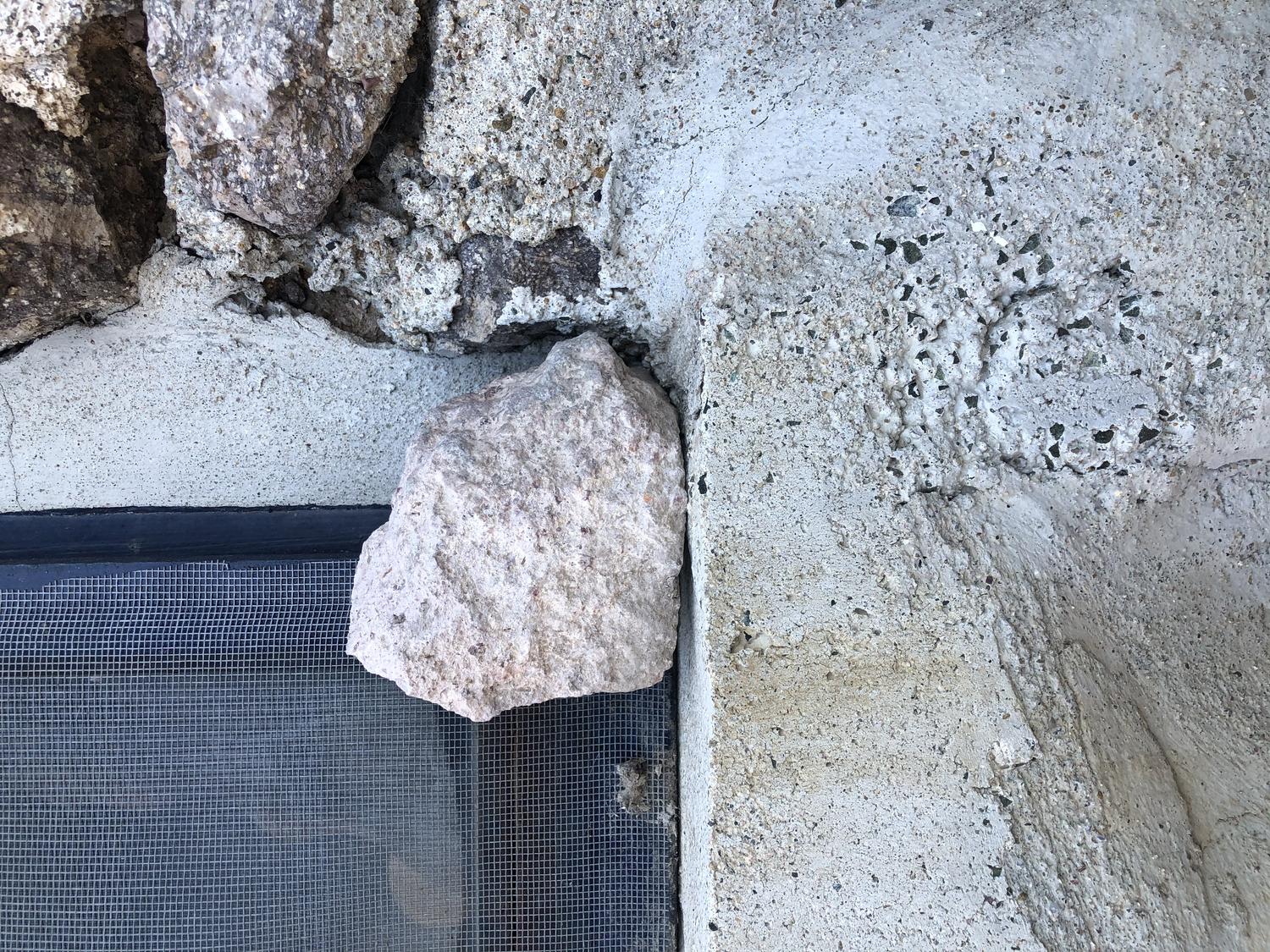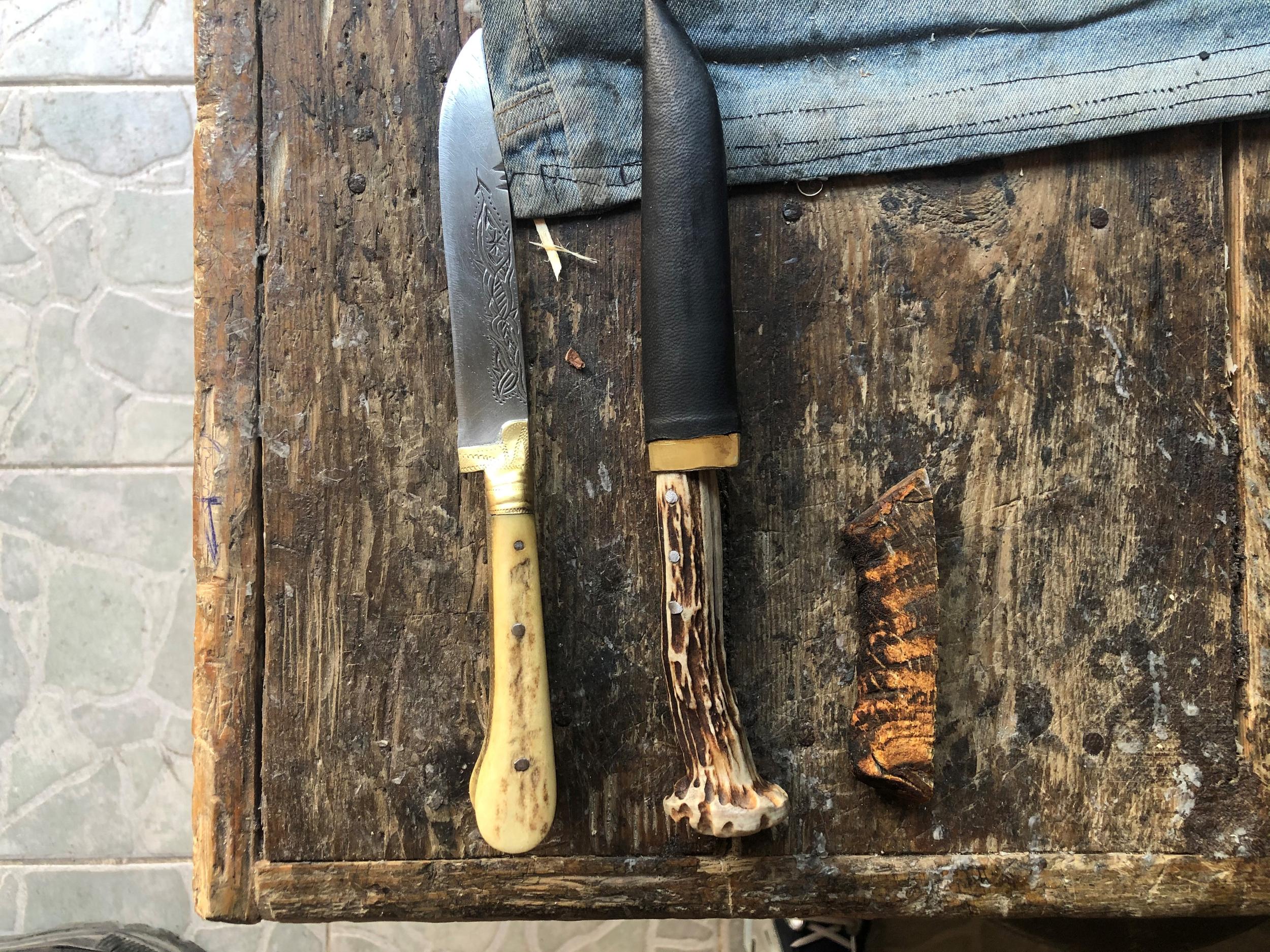3 Material Tales of Babakale
Fictional Protocols and Desirable Futures, Garp Sessions
with Giulia Civardi et al.
garpsessions2020︎︎︎
with Giulia Civardi et al.
garpsessions2020︎︎︎
INTRODUCTION
Three material tales of Babakale emerged from my encounters with fishnets, stones and knives, respectively. These are tales, embedded in a temporality of past traditions and present practices, wary of attaining an absolute representation of the many realities that are unfolding as I type. The material encounters entangled with peer discussions followed by my personal reflections work as entry points into the material histories and presents of the village, and I, as an outsider, who has gotten only a glimpse of them, could humbly narrate what I have encountered. Practical difficulties of conducting and writing a thorough fieldwork in the duration of the residency aside, I consciously shy away from drawing any conclusion and leave the question of desirable futures open-ended. Still, if there is any future I desire, it is one that is caring; caring for the ones that cannot speak back either for they do not speak the canon, or merely for they do not have a voice.
Care for the material, whether it be a fishnet or an animal’s horn, is a running theme across the three tales. In Fishnets to conquer, to care for, I explain how fishermen knit and care for their fishnets, which they use to capture the fish. In Stones to find balance, to build shelter, I tell the story of how careful observations of stones, their abundance and versatile nature have translated and continue to translate to different affordances in the village. In Knives to kill, I narrate how the knifemaker extracts the animal horns from the animal in a caring manner, and turns them carefully into knife handles.
The texts are reconstructions of my field notes including ethnographic interviews with fishnet knitters and the knifemaker, the jottings and photographs I took, and my later reflections after leaving Babakale. Field descriptions are in romans, whereas Turkish originals of some phrases are in italics in square brackets. Italics are also used to put emphasis on certain terms. All visuals are by the author unless stated otherwise.
My first impression of Babakale emerged when I searched the village on Google Maps: A seaside village, curiously looking down on the Aegean Sea and the Greek island Lesvos. Having spent almost one week in the village now, I feel I could elaborate more on this relation with the sea and its animals.
It did not take long for me to understand just how significant fishing is for Babakale’s economy. I remember how overwhelmed I was on the day of my arrival when I first saw the port. “How huge [for a village]” I thought, not knowing back then that the region was known for its fishing economy for centuries (de Bruijn 1714).
I was at Karayel, one of the two seafood restaurants in the village. There are also three shops where fishnets are made. Note that there is only one grocery store in the village. So you get an idea of just how vital the sea, but especially fishing, is for the village. Because the economy relies upon fishing, through which villagers manage their everyday lives, I zoom into one of the materials that sustains this economy, that is, fishnets.
Fishnets, used by the fishermen to capture the fish in the sea, are yarns of different colours knitted into a grid of different sizes. Their sizes vary according to the size of the fish in question. Although available as mass-produced, the locals continue to knit handmade fishnets around the village in the shops, or in the village square. A quick glimpse into the fishnet welcomes the passer-by into the colorful world of nets knit in different sizes, left in the corners, draped over the door; unfinished. My first encounter with fishnet knitters was when I saw four men sitting under the shadow of a tree in the village square, knitting and chatting. Ezgi adds that once a song playing in the background was accompanying their knitting, holding them together just as the knitting nets. In my encounter with them, one of them was knitting the fishnet, accompanied by an older guy, who seemed knowledgeable about the craft and was willing to answer my questions. Behind, there were two young men knitting. They were not inside a shop, but rather were using the public space, the village square, and the tree’s shade as a place to knit. The tree was used as an infrastructure for providing shade, but also providing surfaces of reference when building the surface on which the knitting occurs.
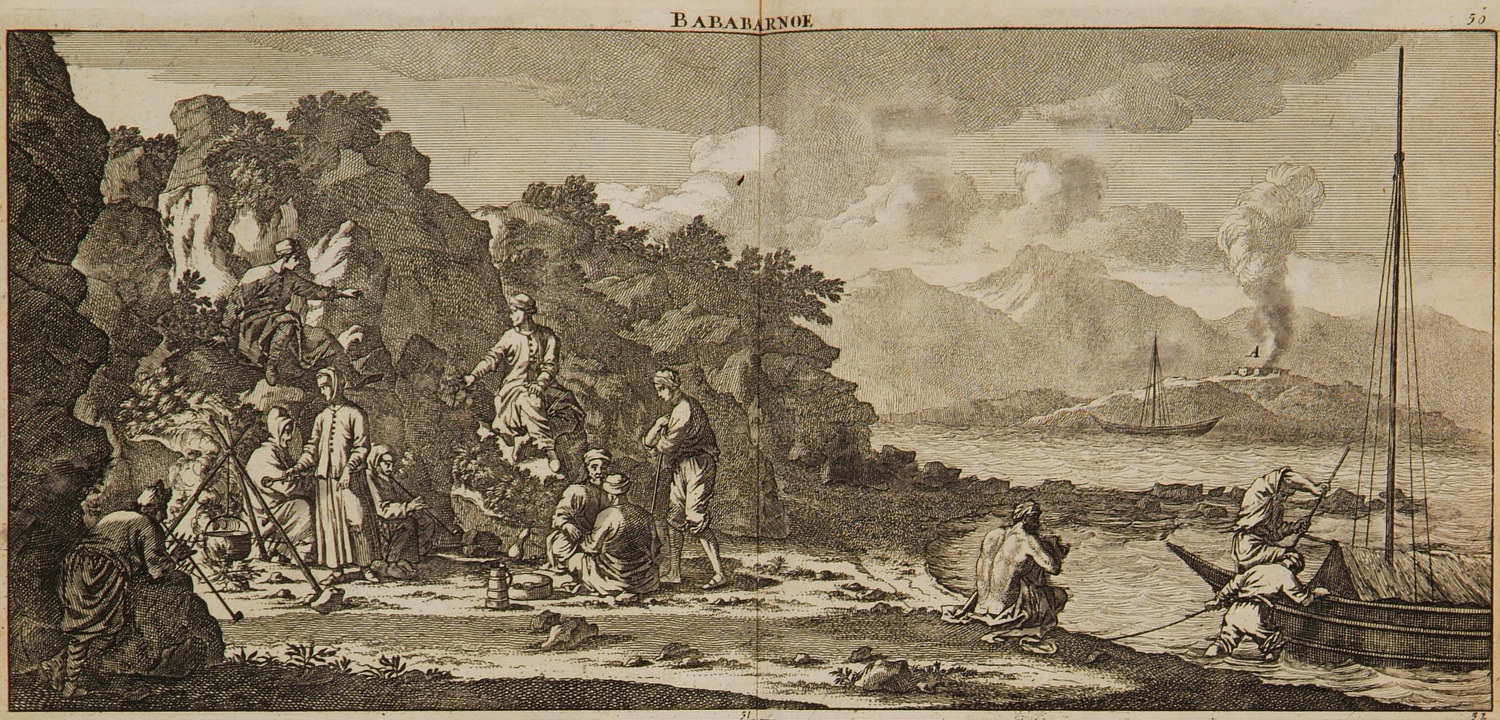
The encounter between Cornelis de Bruijn and local fishermen in Bababurnu opposite Lesbos. Lesbos with Molyvos castle in the background. Cornelis de Bruijn. 1714.
FISHNETS TO CONQUER, TO CARE FOR
“The yarn is made from nylon, polyamide”, Cem explains, for nylon provides strength. Still, the yarn tears off from time to time, require ongoing care (Denis and Pontille 2015), which would then prevent its dematerialization (Ingold 2007): “The sun first washes it [rengini açar], and eventually tears it [yakar],” explains one villager. A tear in the net is undesired for it damages the consistency of the grid, making the net ineligible, or difficult the least, to work with. In order to prevent such tears, “you should not place it [the net] under the sun,” explains another villager. Placing the net in the shadow after use emerges as a technical act of care. Care aside, fishnets cannot always be protected against the evils of the outside world. He continues: “Dolphins […] the yarn tears off when you capture a dolphin in the net”.

A fishnet left drying in the shade, a technical act of care.
In order to eliminate such incidents, animals to be hunted need to be confused. This confusion is made through careful calculations as to how the fishnets mimic a natural state of being: “Leave the net not so tight, but rather loose,” suggests the fishnet knitter to his customer who wants to hunt the snakes in his reeds [sazlık]. He then continues: “Because when it [the animal] feels a threat, it [the animal] immediately swims forward but stronger. If you leave the net loose, then it gets entangled in the net, so you can capture it”. The fishnet, an external substance that enters an animal's environment, is given a drape, rather than a stretch, mimicking the niche (Gibson 1977), or habitat in general, for nothing in nature appears in grids. So the drape conceals the grids, potentially making them look like reeds, or a human trash hanging. This strategy is significant for it builds upon existing observation of the environment and the animal, which is then further utilized in capturing it. The way in which this utilization occurs attempts to stage a natural environment, leaving the traces of the human touch, keeping in mind the ways animals are likely to behave.
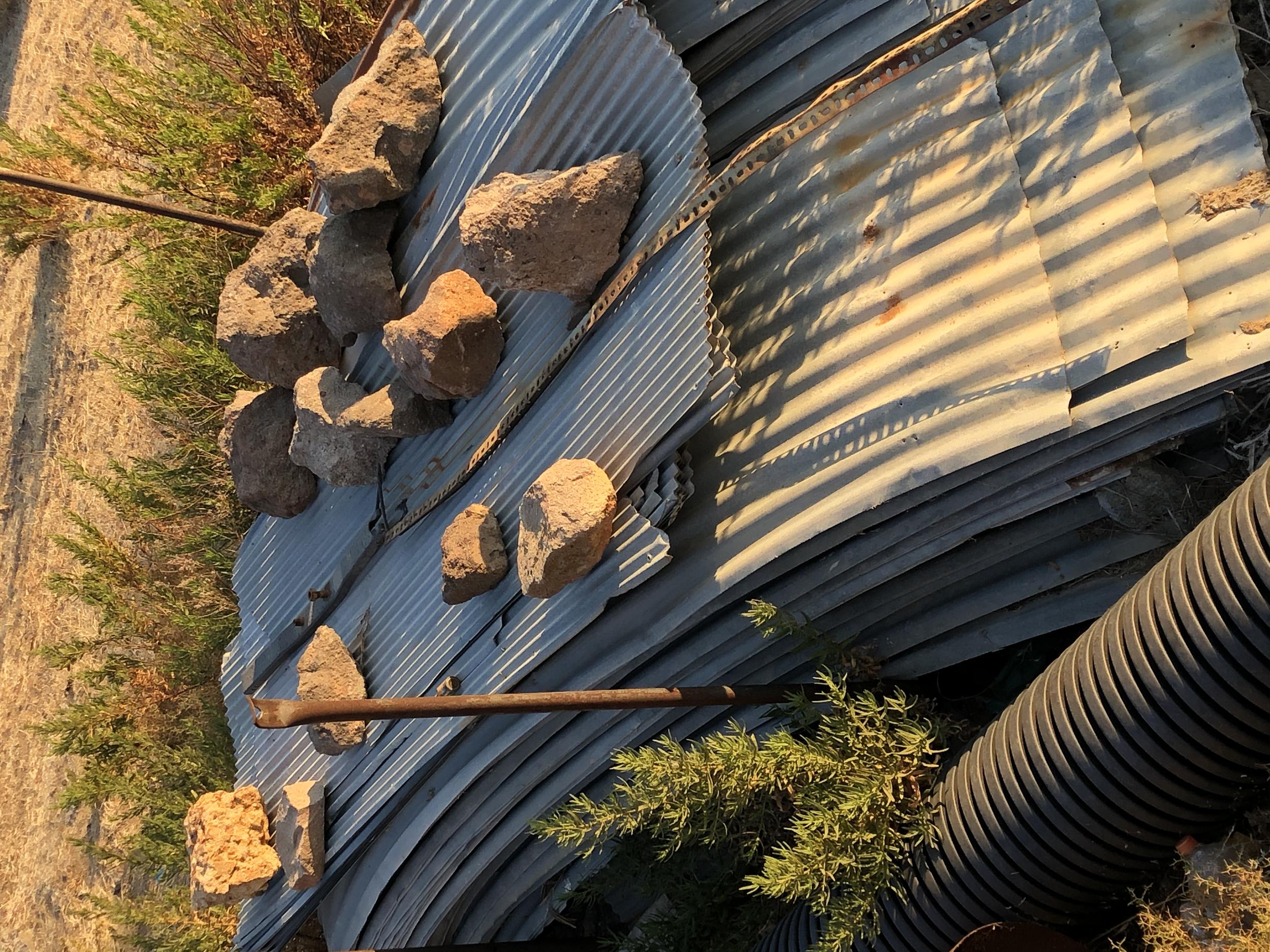
Stones.
STONES TO FIND BALANCE, TO BUILD SHELTER
Stones are witnesses of time. “To know the story of our earth”, Lara cites Malidoma Patrice Somé (1999), “... is to listen to the rocks”. They are silent yet resilient, adaptable, malleable. They are shaped by the sea, by the wind, by the settlers. If we were to write the history of the stone, after Ingold (2007), what would we write about? Maybe we would write on how it emerges from matter, how it’s used, and how it transforms into dust and sand. I would probably start with its use for it comes the most natural to me. In Babakale, stones captured my attention due to their abundance. They are everywhere, in different shapes, serving different purposes from defining/marking spaces to preventing the undesired effect of Babakale’s wind.
Stones of different sorts serve various purposes.
The weather in Babakale, as I have experienced it, is windy. The wind is so strong at times that you don’t feel the heat under the sun. It immediately takes away your sweat, leaving you with a sense of breeze. “It is distracting”, says Deniz, presumably referring to its unpredictable nature to the observer.
The wind and the stones have this relationship I find interesting. The wind shapes the stones over time, just like the water. It dissolves it by removing teeny tiny particles. The stone, on the other hand, is utilized by settlers in their resistance to the wind. Its abundance, its versatility and its weight all contribute to as to why the stone is utilized. Wind shapes the stone, throws it, breaks it, but because it is maybe the most resilient actor of all, it is chosen to resist against it.
The castle, one of the landmarks of the village, is just across us. It stands proudly at the edge, overlooking the Aegean Sea. You cannot help but notice how ordered the stones are placed and how designed it feels. The stones feel like they are captivated in such a way that they can neither escape nor give in to the wind. The human forces on the stone disrupts this timeless dialogue between the wind and the stone.
Last year, around the same time, I had the chance to document stones as well. Stones dominated Gozo island from the very material houses are built with to small pebbles utilized in Gozitans’ ad-hoc solutions. From these two sets of observations in seemingly distinctive/disparate geographies, I will attempt at an anthropocentric generalization only to disrupt it. That stones are formative to humans’ existence. Lara weaves another thread. That if stones are the memory of the earth and the nexi of many stories, each story could be a guide in the ebb and flow of life.
And yet humans are not as significant as one would have thought within the lifespan of a stone. Humans’ efforts to shape the stone is just a moment in an ongoing, multi-actored web of rock shaping1 in time and space. Rejecting the view of matter as a passive actor giving in to external forces but lacking the agency to shape the course of this shaping, the stone is an actor in itself; an actor that is malleable yet resilient, silent yet abundant within the generative fluxes of life.
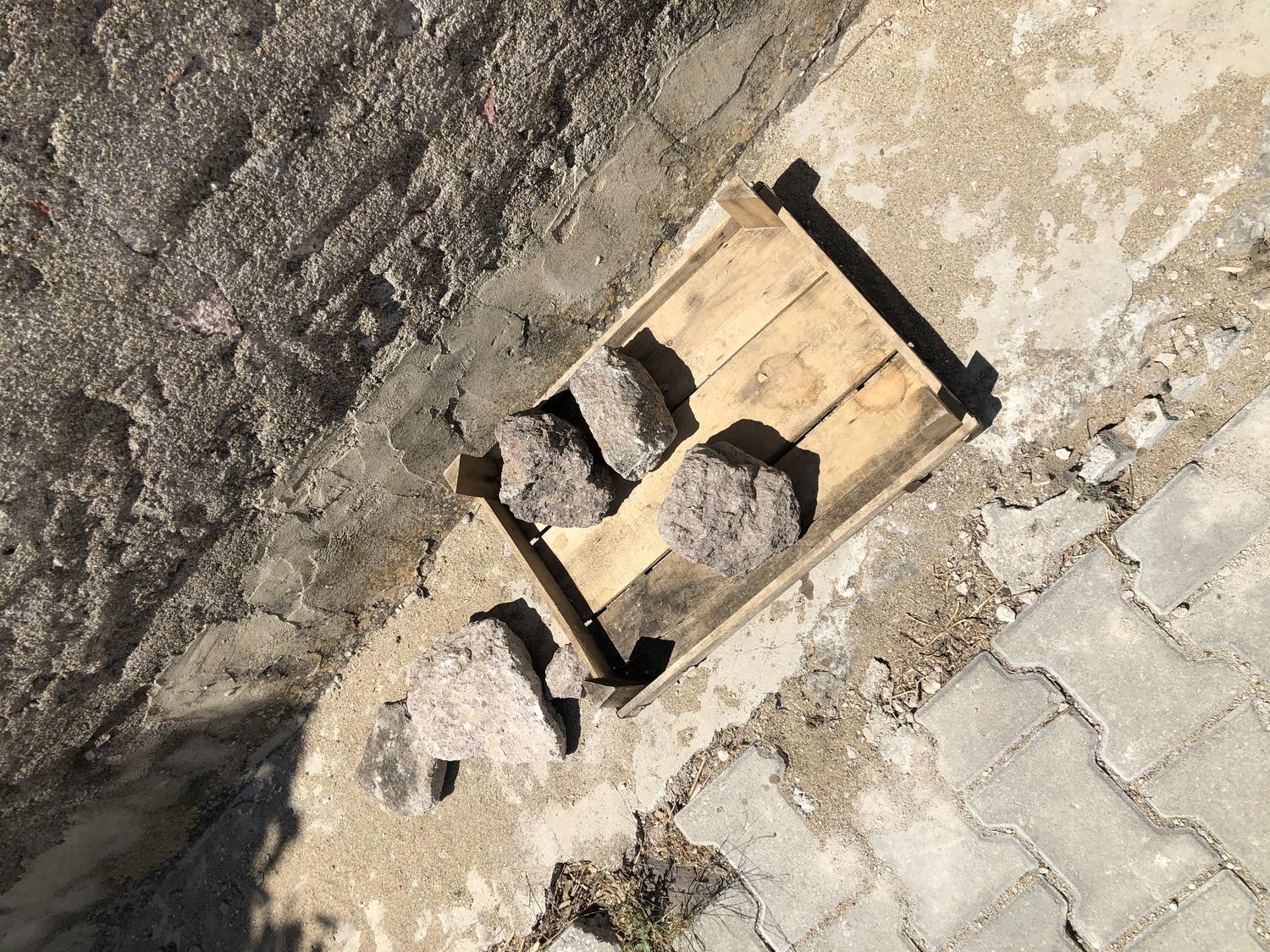
Stones that resist the wind.
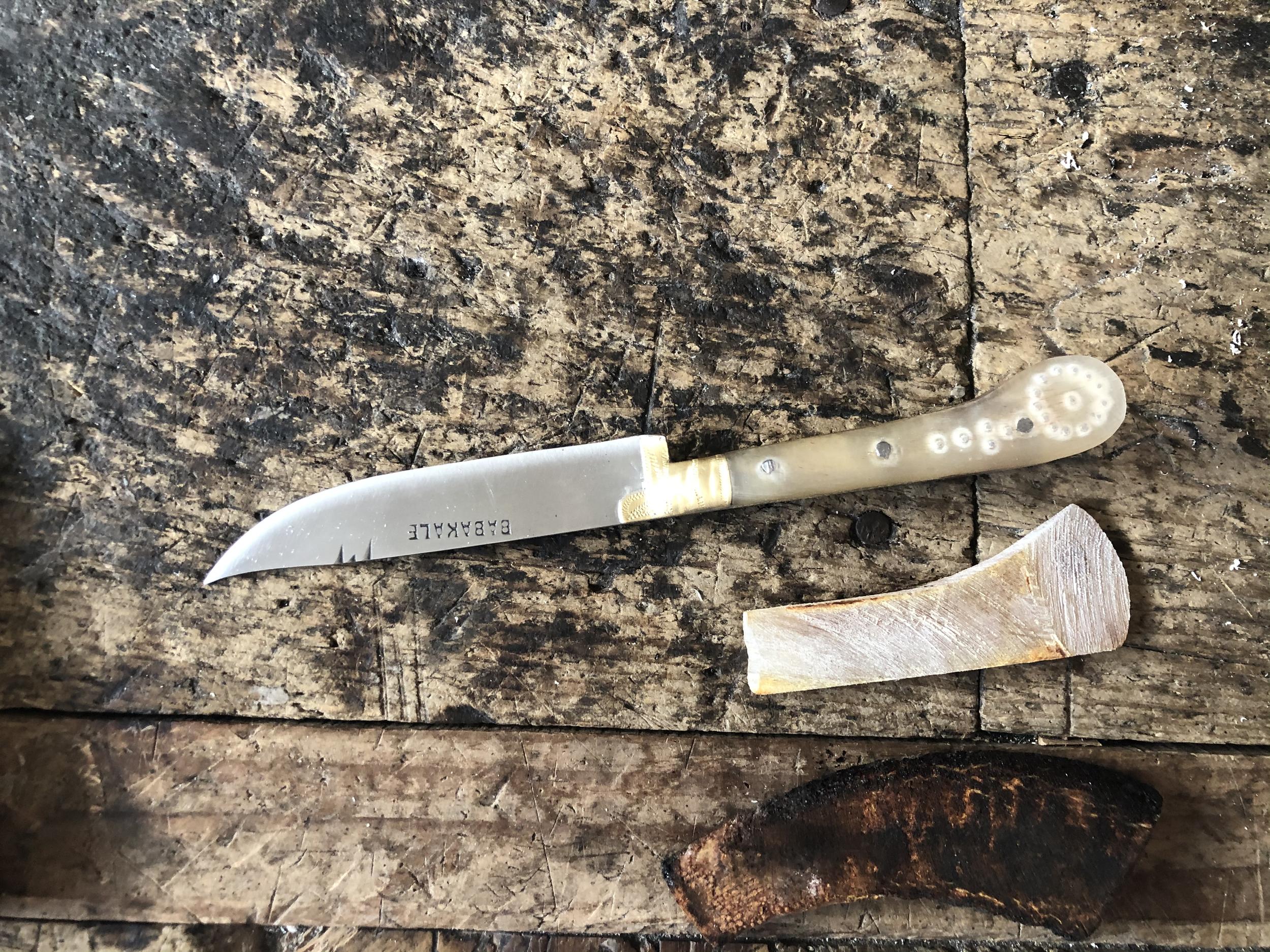
Knife with a blade that reads “Babakale”.
KNIVES TO KILL
Animals are materials. Their meat, their bones, their horns, and their skins go through major transformations to become the very materialities we engage in our everyday lives (Meindertsma 2007). One of the places in Babakale to observe just that is the knifemaking atelier. During our visit to the knifemaker, he warmly welcomed Cem and I, and went over his making process, the materials he uses and their histories.

Horns.
One of my early observations was how the atelier seemed to have been designed in such a way that enhanced his workflow. When you enter the shop, you see on the right the place where he melts the metal. On the left, there seems to be a heightened surface, with various tools, helping him further shape the metal. On the walls, you see the portraits of his paternal ancestors together with a portrait of Atatürk, all of which he proudly exhibits. This paternal feel is intertwined in his historical explanation of the craft:
Knifemaking in Babakale dates back to the Ottomans. The village was home to a knifemaking atelier back then, which would distribute the knives made to the Ottoman land via ship.
Seafaring activities, which played a significant role in the expansion of the Empire, helped collect hunts, their horns and their teeth. Horns and teeth were diverse and prolific. The knifemaker reaches to the cupboard on the wall to get one of the oldest knives he has. Made out of walrus ivory, this knife feels fancy yet handy. The metal part is broken, so the knife cannot function. But this does not lessen any of the value this Ottoman knife holds.
The knives follow a certain template. If a customer were to occasionally ask for a knife of a different shape, the knifemaker tells me, he would emphasize that this is the shape, the result of centuries-long tradition. The knives have a flat surface on one side, which enables the knife to fall back on, leaving the sharp edge of the knife looking upward. In case a thief would break in, the knifemaker illustrates, it would be highly likely that he would step on the knife, hurting himself. He continues: “There are two functions for the knife; one based on need, and the other to kill a man”. Although to kill and to need, I feel, may not necessarily describe mutually exclusive conditions, as in a hunter killing the hunt for they need to survive, I remain silent and pay attention: “My father made me promise that I would not make knives for killing”. When I ask what a dagger does, his explanation in a straightforward manner: “To cut a man [adam kesmek]”
I am left pondering. What happens when you need to kill? Who is the man in his response? Which bodies does “man” include and exclude? Where do you draw the line to justify the need to kill? How quick are we to formulate animal killings as need through which we justify the act of killing? I don’t voice any of these questions. I have learned very well from my fieldwork training that those are not the questions I am allowed to ask. So I listen. I do my best to suppress any judgement.
Dagger, the knifemaker elaborates, has a cylindrical path that follows along the axis of the knife, which helps the knife to be pulled back, after being inserted into the skin. Pulling back is necessary for an effective kill. The knife causes a wound in the body, and once pulled back, results in blood loss, which eventually kills the body.
A deadly concern, yet caring in its attempt to optimize the pain.
The handles of knives vary in terms of the material used. Horns of deers [karaca], goats [keçi], rams [koç] are all used to make handles. Lara weaves a connection by commenting on the Nokhur Cemetery in Turkmenistan, where “goat horns sit atop gravestones” symbolizing “the strength and endurance one needs to live a life on the mountains”. Rising crookedly amid the brown of the steppes, Google images reveal, the gravestones heighten the horns of various sizes, sometimes accompanied by the skull of the animal, helping horns take center stage in the cemetery.
I am intrigued by the shared symbolism of animal horns in peculiar contexts in disparate and distant geographies. As I was about to relate this to the resilient materiality of the horns compared to the vulnerable and ephemeral flesh, I learned that knifemaking tradition in Babakale has Kazakh origins.2
Yet, even horns require certain care to be made eternal. Horns’ eternity depends heavily on their workability as materials, which includes knowing how to clean them and approach them, how to make them malleable and not break them. First and foremost, horns are kept for six to eight months in a climate that is sunny and airy but not humid. The knifemaker illustrates a memory of his where he came across lots of horns being kept and transformed. It is a room without a roof, enabling sun and air to come inside, but not the humidity that much. “Nowadays”, explains the knifemaker, “the horns are bought from the slaughterhouse [mezbaha]”, making invisible the history of how the horn has been obtained.
Handles made from animal horns.
The care for the hunt is a recurring topic during our conversation. Whether it be through not wasting any part of the animal’s body or avoiding hurting/disabling the animal during the extraction of the horn, the animal, I come to understand, should not suffer.
A compassionate kill, or in other words, halāl3 slaughter.
Islamic doctrines, especially the hadiths,4 suggest a similar approach to the treatment of animals: ‘‘If you kill, kill well, and if you slaughter, slaughter well. Let each of you sharpen his blade and let him spare suffering to the animal he slaughters’’ (Sahīh Muslim 10:739, cited in Foltz 2014). Such hadiths preach to lessen the animal’s pain: Animals, resources at the service of man, but that do not belong to man but to God [emanet, amāna] are also at man’s mercy. It then becomes man’s duty to show compassion for its kill, and to ensure animal welfare. Similar to Islamic rituals in killing animals, the knifemaker, too, explains the rituals surrounding horn extraction. Sometimes animals leave their horns on the ground, making it easier for the hunter to collect, which eliminates the need for killing to get the horn or the meat. One would expect that the Feast of Sacrifice [Kurban Bayramı] would provide many horns for the knifemaker. To the contrary, knifemaker explains, those animals do not make a good candidate for they are usually young [genç mal]. Other times, horns are extracted from a living animal. In case rituals are not followed, the animal suffers. Following a careless extraction, he explains, the cut part starts to bleed: “It holds blood, the head swells, like a kind of inflammation. If you make a cut in the area, that animal may shed that blood and not die. [Kan tutar, kafası şişer, bir nevi iltihap gibi. Kesik atarsan, o hayvan o kanı akatabilir ve ölmeyebilir.]”
FOOTNOTES
- I avoid the word “formation” for it denotes a direction in the shaping of rock, as if the rocks are formed by terrestrial conditions only.
- It is explained in various sources that the first knifemaker masters were of Kazakh origin, and were brought to Babakale during Ottoman rule. Knifemakers today are the descendants of the first Kazakh masters. See here: kulturportali.gov.tr︎︎︎ milliyet.com.tr︎︎︎
- that which is permissible under Islam.
- reported statements or actions of Mohammad.
